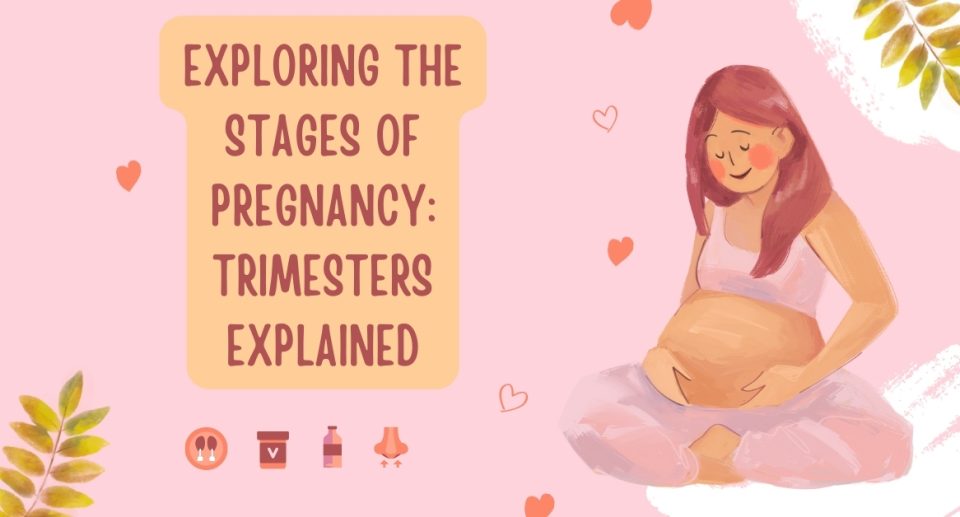Pregnancy, often hailed as a miraculous and transformative experience, is a remarkable journey that spans approximately nine months. This period is divided into three distinct phases known as trimesters, each marked by its unique physiological changes, challenges, and milestones. From the inception of conception to the moment of childbirth, a woman’s body undergoes a series of remarkable transformations.
Table of Contents
ToggleWhat Happens During the Trimesters of Pregnancy?
During the first trimester of pregnancy, which spans weeks 1 to 12, the embryo forms major organs and structures, and the fetus’s heart begins beating. Women may experience morning sickness and fatigue during this time.
The second trimester, from weeks 13 to 26, is often referred to as the “honeymoon phase” due to reduced nausea and increased energy. The fetus grows rapidly, and expectant mothers may start feeling fetal movements.
In the third trimester, weeks 27 to 40, the fetus continues to grow and mature. This period can bring discomfort as the baby’s size increases, including backaches, frequent urination, and difficulty sleeping. Towards the end, the baby settles into the head-down position in preparation for birth, and Braxton Hicks contractions may occur as the body prepares for labor.
First Trimester: Conception to 12 Weeks
The first trimester is a time of wondrous beginnings and significant adaptations as the fertilized egg transforms into a recognizable human form. It encompasses the period from conception to approximately 12 weeks into the pregnancy. The first trimester is a time of rapid cell division and the establishment of the crucial foundation for the growing fetus.
Physical and Emotional Changes During the First Trimester
During this phase, a woman’s body undergoes a series of profound changes. Hormones surge to support the pregnancy, leading to symptoms such as morning sickness, fatigue, breast tenderness, and frequent urination. These symptoms, although challenging, are indicative of the body’s profound adjustment to the growing life within.
On the emotional front, many expectant mothers experience a mix of excitement and anxiety. The realization of becoming a parent, coupled with the physical discomfort, can trigger a range of emotions. Partner support and open communication can be instrumental in navigating these emotional fluctuations.
Fetal Development During the First Trimester
Fetal development is a remarkable process during pregnancy, encompassing the growth and maturation of organs, limbs, and sensory systems in the developing baby.
Monitoring devices, such as ultrasound machines and fetal heart rate monitors, play a pivotal role in tracking this intricate progression. These tools provide real-time insights into the baby’s well-being, allowing healthcare professionals to ensure optimal growth and address any potential concerns throughout the pregnancy journey.
Remarkable changes occur in the developing embryo during the first trimester. By the end of the third week, the neural tube forms, eventually developing into the brain and spinal cord. Organs such as the heart, liver, and kidneys begin to take shape. By the end of the eighth week, the embryo transitions to the fetal stage, with all essential organs present, albeit at a rudimentary stage.
Prenatal Care During the First Trimester
The first trimester is a critical time for prenatal care. Expectant mothers should schedule their first prenatal check-up to ensure the pregnancy is progressing as it should. Prenatal vitamins, a balanced diet, and proper hydration are vital during this phase to support the growing fetus and the mother’s well-being.
Second Trimester: 13 to 28 Weeks
As the first trimester’s challenges begin to ease, the second trimester emerges as a period of relative stability and increased comfort for many pregnant women. Spanning from week 13 to week 28, this phase is often considered the “golden period” of pregnancy due to reduced symptoms and an increased sense of well-being.
Physical and Emotional Changes in the Second Trimester
During the second trimester, morning sickness usually subsides, and energy levels may increase. This is also when the famous “pregnancy glow” often becomes evident due to improved blood circulation and hormonal changes. However, as the baby continues to grow, discomfort from backaches and round ligament pain might arise.
Emotionally, many women find this period to be one of increased contentment. As the baby’s movements become noticeable (usually around the 20th week), a sense of connection and wonder deepens. However, body image concerns and worries about the impending responsibilities of parenthood can still be present.
Fetal Development in the Second Trimester
The second trimester is marked by substantial fetal growth and development. By week 16, the fetus is covered in fine hair called lanugo, and by week 20, the baby’s eyebrows and eyelashes are well-formed. The baby’s senses, such as hearing and taste, begin to develop, and the mother might feel the first fluttery sensations of fetal movement, known as “quickening.”
Prenatal Care in the Second Trimester
Regular prenatal check-ups continue during the second trimester to monitor the health of both the mother and the developing fetus. Diagnostic tests, such as ultrasounds, may be performed to assess the baby’s growth and ensure proper organ development. Staying active with doctor-approved exercises and maintaining a balanced diet remain important aspects of a healthy pregnancy.
Third Trimester: 29 Weeks to Birth
The third trimester marks the final stretch of pregnancy, characterized by the impending arrival of the baby and the completion of the fetal development journey. Spanning from week 29 until birth, this phase is often a mix of excitement, anticipation, and physical challenges as the body prepares for childbirth.
Physical and Emotional Changes in the Third Trimester
As the baby continues to grow, the third trimester is marked by significant physical changes. The mother’s abdomen expands further, and as the baby’s weight increases, backaches, pelvic discomfort, and shortness of breath might become more pronounced. Sleep disturbances due to increased frequency of urination and difficulty finding a comfortable sleeping position are also common.
Emotionally, the third trimester can be a time of heightened anxiety and anticipation. The imminent arrival of the baby, coupled with the physical discomfort, might lead to mood swings and concerns about labor and parenting. Preparing a birthing plan and seeking support from healthcare providers, family, and friends can alleviate some of these anxieties.
Fetal Development in the Third Trimester
During the third trimester, the baby’s organs mature further, and the chances of survival outside the womb increase significantly. The fetus gains more fat, which contributes to its overall weight and provides insulation to regulate body temperature after birth. By the end of the third trimester, the baby typically settles into a head-down position in preparation for birth.
Prenatal Care in the Third Trimester
As the due date approaches, prenatal care remains crucial. Regular check-ups monitor the baby’s growth and the mother’s health, ensuring that any potential complications are identified and managed. Classes on childbirth and parenting might be beneficial during this phase to help prepare for labor, delivery, and the postpartum period.
Conclusion
The journey of pregnancy, divided into three distinct trimesters, is a testament to the marvels of nature and the resilience of the human body. From the initial stages of cell division and organ formation to the eventual culmination in childbirth, the trimesters offer a comprehensive insight into the intricacies of fetal development.
While each trimester comes with its set of challenges and changes, the collective experience is one of growth, transformation, and an unwavering connection between the expectant mother and her growing baby. Understanding these phases empowers both expectant parents and healthcare providers to provide the best care possible, ensuring a healthy and memorable journey into parenthood.





